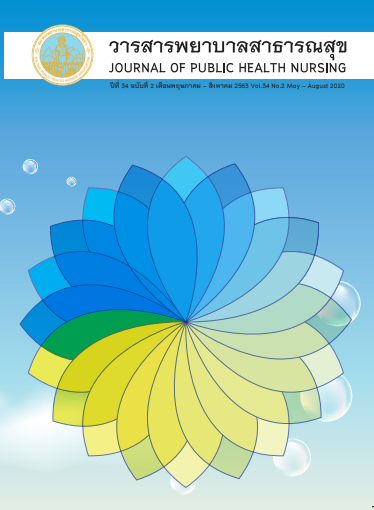Factors Affecting Quality of Life among Laborers Exposed to Noise in Factories, Rayong Province
Keywords:
Quality of life, Industrial workers exposed to noiseAbstract
Noise is a health hazard which affects quality of life. This correlational research aimed to study factors affecting quality of life among laborers exposed to noise in factories, Rayong Province. One hundred and five employees were selected by multi-stage random sampling. The research instrument was a self–administered questionnaire with a reliability of .76. Descriptive statistics and stepwise multiple regression were used to analyze data.
Results showed that 63.80% of subjects were female, mean age was 37 years , average working hours were 12 hours per day, with mean noise levels of 93.2, 92.5, 90.2, and 85.3 dB in the workplaces tested. The workers perceive slightly abnormal levels of hearing 84.67 (S.D.= 13.68). While 94.30% of workers could communicate at a normal level, Audiometric tests showed that 60% had some hearing loss. Workers showed mild stress (M= 2.90, S.D.= 2.89), high self - esteem (M= 36.62, S.D.= 3.04), and a high quality of life (M= 4.10, SD= 0.80). This study revealed that self-esteem (Self) and perceived hearing ability (Per.H) had a statistically significant association and predicted quality of life (p < .001) while explaining 25.50 percent of quality of life using the following equation: Z’QOL= 0.401’Self – 0.266’Per.H
Results can be used by health care providers to design self-esteem strengthening activities, especially for workers with perceived hearing loss to increase quality of life.
References
Department of Disease Control. Report disease of occupational [Internet]. 2017 [cited 2020 Jun 10]. Available from http://envocc.ddc.moph.go.th/uploads/situation/01_envocc_situation_60.pdf.
Pollution Control Department. Law of Noise and vibration Pollution [Internet]. 2017 [cited 2016 Jan 2]. Available from http://infofile.pcd.go.th/air/Noise_law.pdf?CFID=19853595&CFTOKEN=64141417.
Pyykko I, Toppila E, Zou J, Kentala E. Individual susceptibility to noise-induced hearing loss. Audiological Medicine 2007; 5(1): 41-53.
Ratanaanekchai T, Srirompotong S. Ear Nose Throat. 3rd ed. Klungnana Khon Kaen; 2011.
Kingkaew P, Werayingyong P, Riewpaiboon W, Potaporn M, Tungkeeratichai J, Kanchanalarp C, et al. Health technology assessment of cochlear implantation: the economic and social perspectives [Internet]. 2009 [cited 2014 Feb 11]. Available from http://resource.thaihealth.or.th/library/academic/12510.2009.
Hickson L, Allen J, Beswick R, Fulton M, Wolf D, Worrall L, et al. Relationships between hearing disability, quality of life and wellbeing in older community-based Australians. Australian & New Zealand Journal Of Audiology 2008; 30(2): 99-112.
Preminger J, Meeks S. The influence of mood on the perception of hearing-loss related quality of life in people with hearing loss and their significant others. International Journal of Audiology 2010; 49(4): 263-71.
Hintermair M. Self-esteem and satisfaction with life of deaf and hard-of-hearing people - a resource-oriented approach to identity work. Journal Of Deaf Studies & Deaf Education 2008; 13(2): 278-300.
Karnchanaporn L. 3rd ed. Mental Health. Printing of Silapakorn University; 2004.
Osuansri N. Factors Related to Quality of Work among Female Labors in Factories, Nakhonratchasuma Province. Burapha University; 2011.
Rubber Research Institute. Report of Rubber Factory 2013 [Internet]. 2013 [cited 2014 Feb 10]. Available from http://www.rubberthai.com/book/file/uss.pdf
Tabachnick BG, Fidell LS. Improving outcomes in diastolic heart failure. Postgraduate Medicine 2003; 113(3): 51-8.
Cline ME, Herman J, Shaw ER, Morton RD. Standardization of the Visual Analogue Scale. Nursing Research 1992; 41(6): 378-80.
Srimoragot P. Effects of supportive counseling on perceived illness, self-esteem, and morale in cervical cancer patients undergoing radiotherapy. Mahidol University; 1993.
Center of Pharmaceutical Outcomes Research. Cost-Utility Analysis of Intravenous Immunoglobulin (IVIG) for the treatment of Chronic Inflammatory Demyelinating Polyradiculoneuropathy (CIDP). Naresuan University; 2012.
Chutha W. Mental Health Screening. The War Veterans Organization of Thailand; 2002.
Hintermair M. Health-related quality of life and classroom participation of deaf and hard-of-hearing students in general schools. Journal Of Deaf Studies & Deaf Education 2011; 16(2): 254-71.
Muluk NB, Oguzturk O. Occupational Noise-Induced Tinnitus: Does It Affect Workers' Quality of Life?. Journal Of Otolaryngology Head & Neck Surgery 2008; 37(1): 65-71.
Carlsson P, Hall M, Lind K, Danermark B. Quality of life, psychosocial consequences, and audiological rehabilitation after sudden sensorineural hearing loss. International Journal Of Audiology 2011; 50(2): 139-44.
Hua H, Karlsson J, Widén S, Möller C, Lyxell B. Quality of life, effort and disturbance perceived in noise: A comparison between employees with aided hearing impairment and normal hearing. International Journal Of Audiology 2013; 52(9): 642-9.
Hallberg L, Hallberg U, Kramer S. Self-reported hearing difficulties, communication strategies and psychological general well-being (quality of life) in patients with acquired hearing impairment. Disability & Rehabilitation 2008; 30(3): 203-12.
Kushalnagar PP, Topolski TD, Schick BB, Edwards TC, Skalicky AM, Patrick DL. Mode of Communication, Perceived Level of Understanding, and Perceived Quality of Life in Youth Who Are Deaf or Hard of Hearing. Journal Of Deaf Studies & Deaf Education 2011; 16(4): 512-23.
Downloads
Published
How to Cite
Issue
Section
License
บทความที่ตีพิมพ์และแผนภูมิรูปภาพถือเป็นลิขสิทธิ์ของวารสารพยาบาลสาธารณสุข (Thai Public Health Nurses Association)







